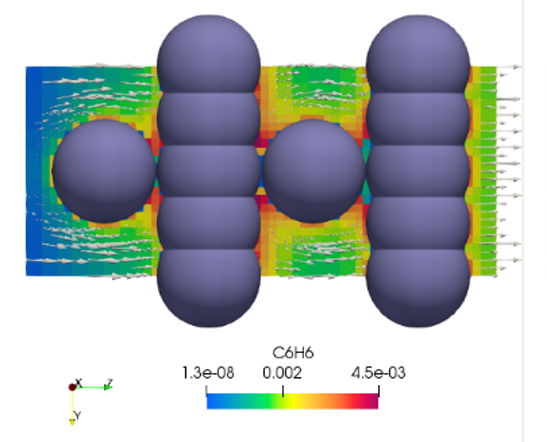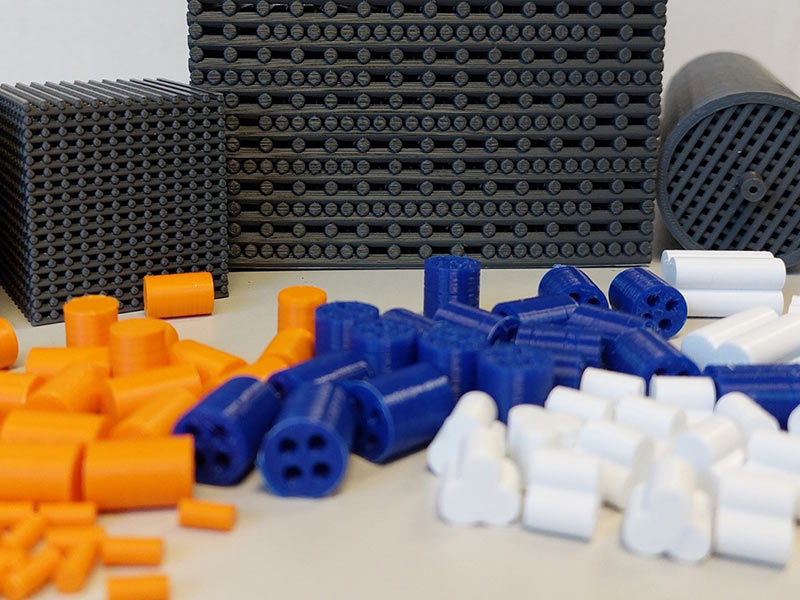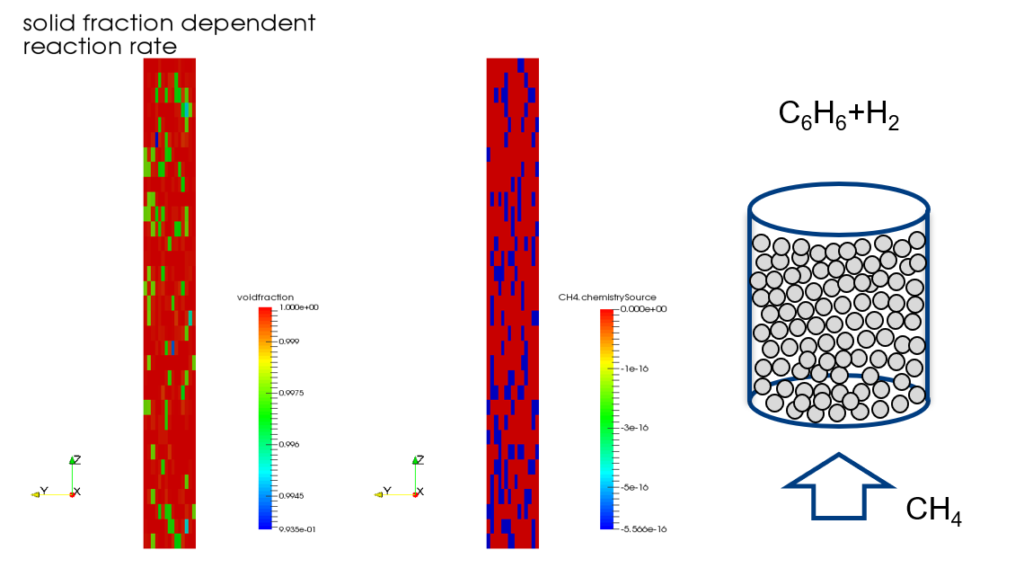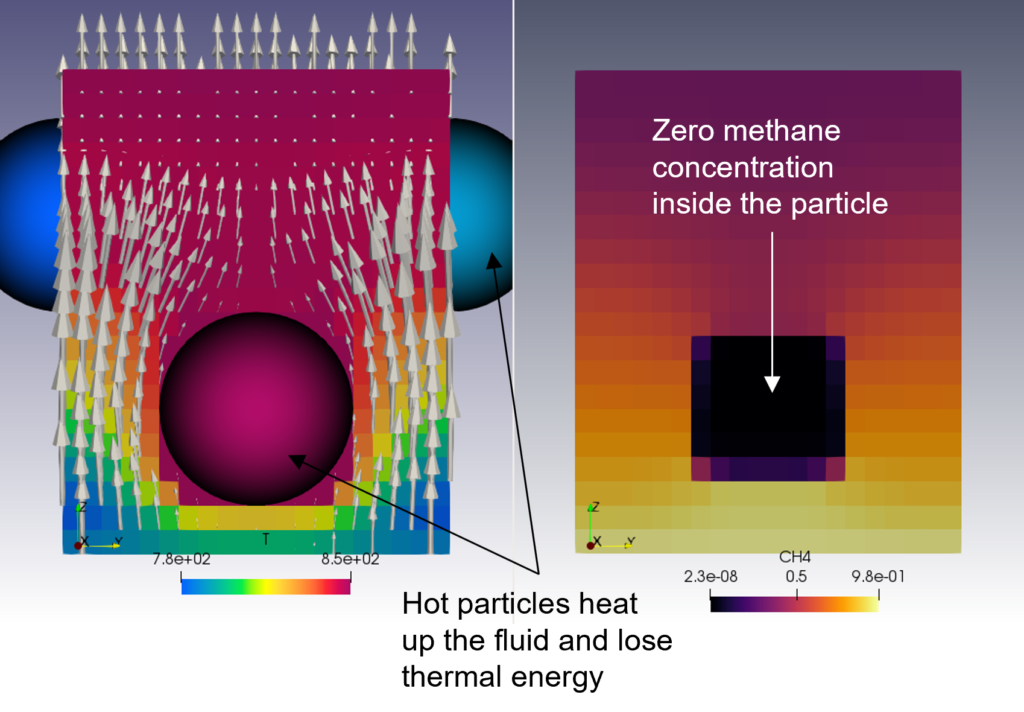Complex processes often depend on the combination of a large number of physical and chemical procedures. CFDEM®coupling provides a large number of models for depicting phenomena like heat transfer, melting, evaporation or chemical reactions.

This video shows a simulation of solid-liquid mixing in stirred tank. A semi-implicit immersed boundary method has been used to solve the fluid flow due to the rotating geometry. The CFD-DEM coupling, however, is of the unresolved type. Please, refer to the following publication for further information: Blais, B. et al. (2016). Development of an unresolved CFD–DEM model for the flow of viscous suspensions and its application to solid–liquid mixing.

By loading the video, you agree to Vimeo's privacy policy.
Learn more
The animation shows the simulation of the release of API from coated particles in a dry powder inhaler. On the left side we see the API concentration in the air, on the right side the coating on the particles.

By loading the video, you agree to Vimeo's privacy policy.
Learn more
Model of a melting pot realized with CFDEM®coupling. Particles are heated up by particle-wall contact and convective heat transfer. If the particles reach a melting temperature, they shrink and this volume is transferred to the liquid phase. This results in a three phase system with solid particles, gas and liquid.

By loading the video, you agree to Vimeo's privacy policy.
Learn more
A spray wets the inserted particles. Both the walls and a hot gas stream heat up the particles which triggers evaporation. The water vapor is transported by the fluid.

By loading the video, you agree to Vimeo's privacy policy.
Learn more

By loading the video, you agree to Vimeo's privacy policy.
Learn more
Using coupled CFD-DEM to simulate the methane dehydroaromatization within 3D printed catalysts (symbol image on the right). A 1D-3D model is used for being able to resolve the effects that take place at small scales while representing the entire process (large scales, also time-wise) at the same time. The image shows a snapshot of the benzene concentration within a 3D element. The work is carried out in the frame of the ZEOCAT3D project.



By loading the video, you agree to Vimeo's privacy policy.
Learn more
Coupled CFD-DEM simulation of a chemical reaction consisting in the decomposition of methane into hydrogen and solid carbon. The chemical reaction is triggered by the presence of a solid particles. The solid reaction product lays down as a film on the particle surface. This setup was used for validating the reaction model.

By loading the video, you agree to Vimeo's privacy policy.
Learn more

CFDEM®coupling can use Immersed Boundary Method (IBM) to calculate the conductive heat flux between a rigid body and the surrounding fluid.
The heat transfer is enabled by the force model LaEuScalarTempIB (on the coupling side) and by the Aspherix® command enable_heat_conduction (on the DEM side).
Additional feature of LaEuScalarTempIB: prescribe a mass diffusivity inside the immersed bodies to control the transport of chemical species inside/outside the body.

This video shows a simulation of solid-liquid mixing in stirred tank. A semi-implicit immersed boundary method has been used to solve the fluid flow due to the rotating geometry. The CFD-DEM coupling, however, is of the unresolved type. Please, refer to the following publication for further information: Blais, B. et al. (2016). Development of an unresolved CFD–DEM model for the flow of viscous suspensions and its application to solid–liquid mixing.

By loading the video, you agree to Vimeo's privacy policy.
Learn more
Model of a melting pot realized with CFDEM®coupling. Particles are heated up by particle-wall contact and convective heat transfer. If the particles reach a melting temperature, they shrink and this volume is transferred to the liquid phase. This results in a three phase system with solid particles, gas and liquid.

By loading the video, you agree to Vimeo's privacy policy.
Learn more
A spray wets the inserted particles. Both the walls and a hot gas stream heat up the particles which triggers evaporation. The water vapor is transported by the fluid.

By loading the video, you agree to Vimeo's privacy policy.
Learn more

By loading the video, you agree to Vimeo's privacy policy.
Learn more
Using coupled CFD-DEM to simulate the methane dehydroaromatization within 3D printed catalysts (symbol image on the right). A 1D-3D model is used for being able to resolve the effects that take place at small scales while representing the entire process (large scales, also time-wise) at the same time. The image shows a snapshot of the benzene concentration within a 3D element. The work is carried out in the frame of the ZEOCAT3D project.



By loading the video, you agree to Vimeo's privacy policy.
Learn more
Coupled CFD-DEM simulation of a chemical reaction consisting in the decomposition of methane into hydrogen and solid carbon. The chemical reaction is triggered by the presence of a solid particles. The solid reaction product lays down as a film on the particle surface. This setup was used for validating the reaction model.

By loading the video, you agree to Vimeo's privacy policy.
Learn more

CFDEM®coupling can use Immersed Boundary Method (IBM) to calculate the conductive heat flux between a rigid body and the surrounding fluid.
The heat transfer is enabled by the force model LaEuScalarTempIB (on the coupling side) and by the Aspherix® command enable_heat_conduction (on the DEM side).
Additional feature of LaEuScalarTempIB: prescribe a mass diffusivity inside the immersed bodies to control the transport of chemical species inside/outside the body.
